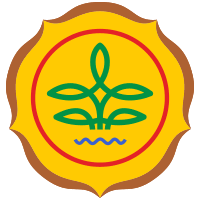Metode Mengatasi Browning pada Eksplan Ulin (Eusideroxylon zwageri) untuk Inisiasi Regenerasi Secara In Vitro
Abstract
Keywords
Full Text:
PDFReferences
Abdelwahd, R., N. Hakam, M. Labhilili & S.M. Udupa. 2008. Use of an adsorbent and antioxidants to reduce the effects of leached phenolics in vitro plantlet regeneration of Faba bean. African Journal of Biotechnology 7(8): 997-1002.
Aliyu and O. Mashood. 2005. Application of tissue culture to cashew (Anacardium occidentale L.) breeding: An appraisal. African Journal of Biotechnology 4(13):1485-1489.
Anjum, S., M. Zia & M.F. Chaudary. 2006. Investigations of different strategies for high frequency regeneration of Dendrobium malones ‘Victory’. African Journal of Biotechnology 5(19): 1783-1743.
Arditti, J. & R. Ernst. 1993. Micropropagation of orchids. John Wiley & Sons, Inc., New York: xiii + 682 hlm.
Eka, Handayani1., Sakka, Samudin., dan Zainuddin Basri. 2013. The Growth Of Dragon Fruit Explants (Hylocereus undatus) at Various Planting Position And Media Composition Via In Vitro Culture. e-J. Agrotekbis 1.
George, E.F., M.A. Hall & G.J. De Klerk. 2008. Plant Propagation by Tissue Culture 3rd Edition. Springer, Dordrecht, Netherlands: ix + 501 hlm.
Hutami, S. 2006. Penggunaan arang aktif dalam kultur in vitro. Jurnal AgroBiogen 4(2):83-88 (IUCN) International Union for Conservation of Nature and Natural Resource. The IUCN red list of threatened species (Internet). (diunduh Agustus 2017) tersedia pada: http://www.iucnredlist.org.
Ko, W. H., C. L. Chen and C. P. Chao. 2009. Control of Lethal Browning of Tissue Culture Plantlets of Cavendish Banana cv. Formosana with Ascorbic Acid. Biomedical and Life Sciences Vol. 96(2): 137-141.
Mohammad Wahyu Dewanto. 2014. Pengaruh Zat Pengatur Tumbuh BAP dan NAA terhadap Pertumbuhan Tunas Ulin (Eusideroxylon zwageri T. et B.) secara in Vitro. Skripsi. Fakultas Kehutanan Institut Pertanian Bogor, Bogor.
Muhammad Haikal. 2011. Pengaruh Arang Aktif Terhadap Pencoklatan Pada Kultur Daun (Dendrobium lasianthera J.J.Sm). Skripsi. Fakultas Matematika dan Ilmu Pengetahuan Alam Universitas Indonesia, Depok.
Newton, R.J., W. Tang, and L.C.V. Outhavong. 2004. Exogenously added polyamines recover browning tissues into normal callus cultures and improve plant regeneration in pine. Physiol Plant 122(3):386-395.
Nirmala. R. 2017. Kendala utama untuk memperoleh bibit tanaman ulin melalui kultur jaringan, (personal communication). April 2017.
Noorhidayah dan Sidiyasa, K. 2006. Konservasi Ulin (Eusideroxylon zwageri teijsm & Binn) dan Pemanfaatannya sebagai Tumbuhan Obat. Info Hutan III.
Rabha, A., N. Hakam., M. Labhilili and S.M. Udupa. 2008. Use of an Adsorbent and Antioxidants to Reduce the Effects of Leached Phenolis in In Vitro Planlet Regeneration of Faba Beans. African Journal of Biotechnology Vol.7(8): 997-1002.
Soerianegara, I. dan R.H.M.J. Lemmens. 1993. Plant Resources of South-East Asia. Pudoc Scientific Publishers. Wageningen.
Tabiyeh, D.T., F. Bernard, and H. Shacker. 2006. Investigation of glutathione, salicylic acid and GA3 effects on browning in Pistacia vera shoot tips culture. ISHS Acta Hort 726.
Taji, M., W.A. Dodd and R.R. Williams. 1997. Plant Tissue Culture Practice. 3rd Ed. University of New England Printery, Armidale. NSW, Australia.
Thomas, T.D. 2008. The role of activated charcoal in plant tissue culture. Biotechnology Advances 26: 618--631. Widiastoety, D dab B. Marwoto. 2004. Pengaruh Berbagai Sumber Arang dalam Media Kultur in Vitro Terhadap Pertumbuhan Plantlet Oncidium. J. Hort 14:1-5.
DOI: http://dx.doi.org/10.35941/jatl.1.2.2019.1972.106-113
Refbacks
- There are currently no refbacks.
Copyright (c) 2019 Agroekoteknologi Tropika Lembab







4.jpg)
.jpg)











